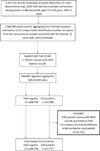The association of injury with substance use disorder among women of reproductive age: an opportunity to address a major contributor to recurrent preventable emergency department visits?
- PMID: 25491709
- PMCID: PMC4330107
- DOI: 10.1111/acem.12548
The association of injury with substance use disorder among women of reproductive age: an opportunity to address a major contributor to recurrent preventable emergency department visits?
Abstract
Objectives: Substance use disorder (SUD) among women of reproductive age is a complex public health problem affecting a diverse spectrum of women and their families, with potential consequences across generations. The goals of this study were 1) to describe and compare the prevalence of patterns of injury requiring emergency department (ED) visits among SUD-positive and SUD-negative women and 2) among SUD-positive women, to investigate the association of specific categories of injury with type of substance used.
Methods: This study was a secondary analysis of a large, multisource health care utilization data set developed to analyze SUD prevalence, and health and substance abuse treatment outcomes, for women of reproductive age in Massachusetts, 2002 through 2008. Sources for this linked data set included diagnostic codes for ED, inpatient, and outpatient stay discharges; SUD facility treatment records; and vital records for women and for their neonates.
Results: Injury data (ICD-9-CM E-codes) were available for 127,227 SUD-positive women. Almost two-thirds of SUD-positive women had any type of injury, compared to 44.8% of SUD-negative women. The mean (±SD) number of events also differed (2.27 ± 4.1 for SUD-positive women vs. 0.73 ± 1.3 for SUD-negative women, p < 0.0001). For four specific injury types, the proportion injured was almost double for SUD-positive women (49.3% vs 23.4%), and the mean (±SD) number of events was more than double (0.72 ± 0.9 vs. 0.26 ± 0.5, p < 0.0001). The numbers and proportions of motor vehicle incidents and falls were significantly higher in SUD-positive women (22.5% vs. 12.5% and 26.6% vs. 11.0%, respectively), but the greatest differences were in self-inflicted injury (11.5% vs. 0.8%; mean ± SD events = 0.19 ± 0.9 vs. 0.009 ± 0.2, p < 0.0001) and purposefully inflicted injury (11.5% vs 1.9%, mean ± SD events = 0.18 ± 0.1 vs. 0.02 ± 0.2, p < 0.0001). In each of the injury categories that we examined, injury rates among SUD-positive women were lowest for alcohol disorders only and highest for alcohol and drug disorders combined. Among 33,600 women identified as using opioids, 2,132 (6.3%) presented to the ED with overdose. Multiple overdose visits were common (mean ± SD = 3.67 ± 6.70 visits). After adjustment for sociodemographic characteristics, psychiatric history, and complex/chronic illness, SUD remained a significant risk factor for all types of injury, but for the suicide/self-inflicted injury category, psychiatric history was by far the stronger predictor.
Conclusions: The presence of SUD increases the likelihood that women in the 15- to 49-year age group will present to the ED with injury. Conversely, women with injury may be more likely to be involved in alcohol abuse or other substance use. The high rates of injury that we identified among women with SUD suggest the utility of including a brief, validated screen for substance use as part of an ED injury treatment protocol and referring injured women for assessment and/or treatment when scores indicate the likelihood of SUD.
© 2014 by the Society for Academic Emergency Medicine.
Conflict of interest statement
The authors have no relevant financial information or potential conflicts to disclose.
Figures
References
-
- Substance Abuse and Mental Health Services Administration. Results from the 2011 National Survey on Drug Use and Health: Summary of National Findings. [Accessed Sep 7, 2014]; NSDUH Series H-44, HHS Publication No. (SMA) 12-4713. Available at: http://www.samhsa.gov/data/NSDUH/2k11Results/NSDUHresults2011.htm.
-
- Nolen-Hoeksema S. Gender differences in risk factors and consequences for alcohol use and problems. Clin Psychol Rev. 2004;24:981–1010. - PubMed
-
- Ouimette PC, Kimmerling R, Shaw J, Moos R. Physical and sexual abuse among women and men with substance use disorders. Alcohol Treat Q. 2000;18:7–17.
-
- Zilberman ML, Tavares H, Blume SB, el-Guebaly N. Substance use disorders: sex differences and psychiatric comorbidities. Can J Psychiatr. 2003;48:5–13. - PubMed
Publication types
MeSH terms
Grants and funding
LinkOut - more resources
Full Text Sources
Other Literature Sources
Medical


